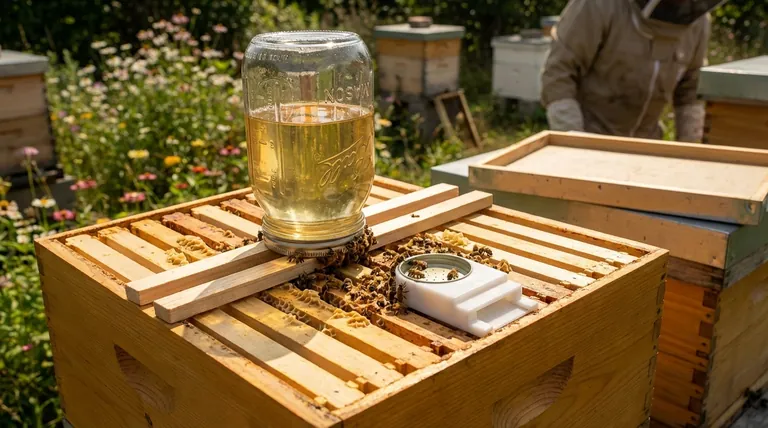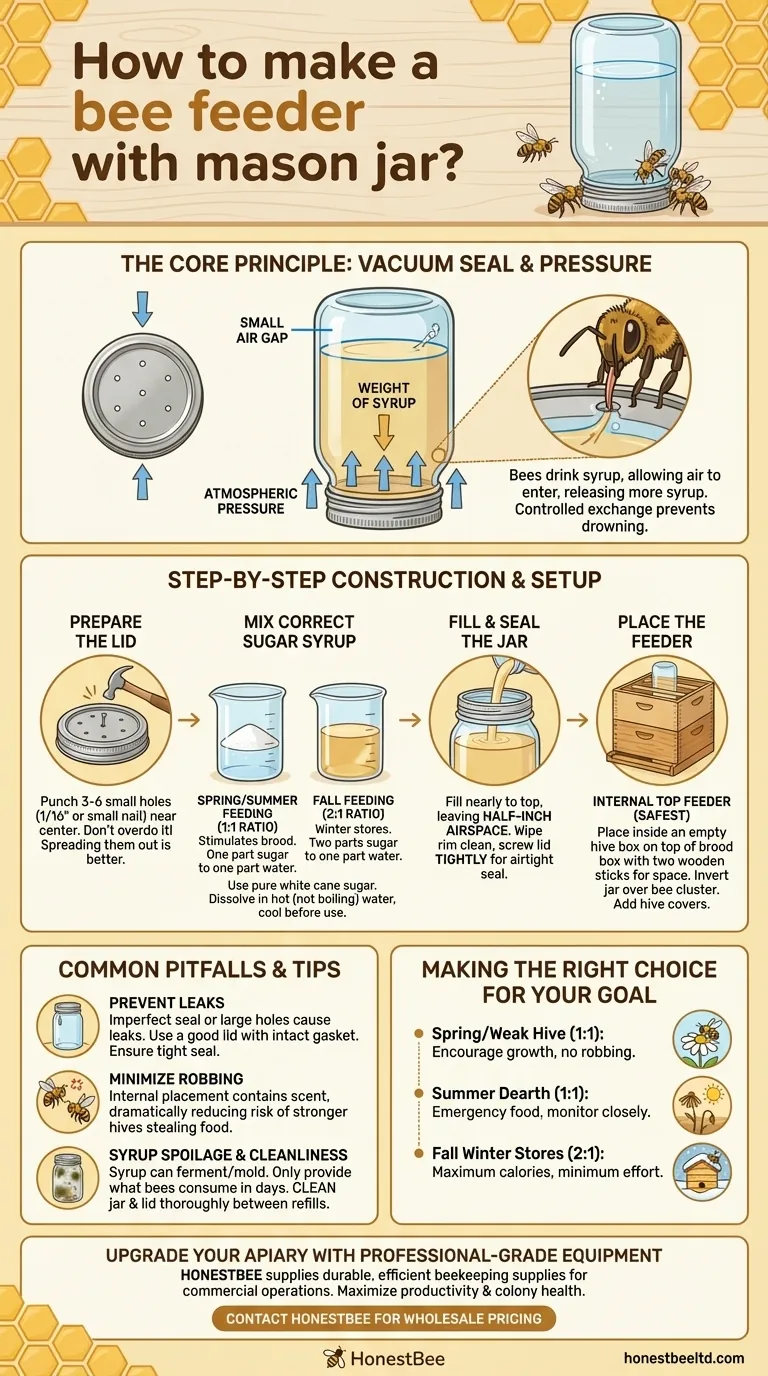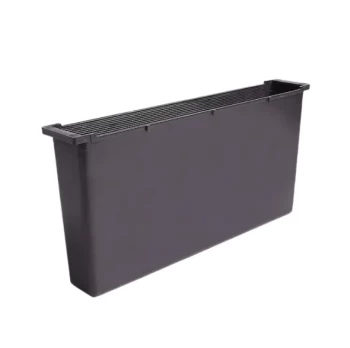To make a Mason jar bee feeder, you will punch several small holes in the jar's metal lid, fill the jar nearly to the top with sugar syrup, and seal it tightly. This simple device is then inverted and placed either inside an empty hive box on top of the frames or at the hive entrance, providing a safe and accessible food source for your bees.
The Mason jar feeder is a trusted method for beekeepers because it uses a simple vacuum seal to dispense syrup safely. This design prevents the syrup from flowing freely, which minimizes waste and significantly reduces the risk of bees drowning in the food source.

The Core Principle: Why This Method Works
A Mason jar feeder isn't just a container; it's a simple atmospheric pressure and vacuum system. Understanding this principle is key to using it effectively and avoiding common problems like leaks.
Creating a Vacuum Seal
When you fill the jar with syrup, leaving only a small air gap, and screw the lid on tightly, you create a sealed system. As you invert the jar, the weight of the syrup creates a slight vacuum in the air gap at the top. This vacuum pressure, combined with the surface tension of the liquid in the small holes, holds the syrup in place.
How Bees Feed
Bees use their proboscis (a straw-like tongue) to draw syrup from the holes. As they drink, a tiny amount of air enters the jar, which allows a corresponding amount of syrup to be released. This controlled exchange ensures the feeder only dispenses syrup on demand.
Step-by-Step Construction and Setup
Building and deploying your feeder requires attention to a few critical details to ensure it functions correctly and safely for your colony.
Step 1: Prepare the Lid
Use a small nail or a 1/16" drill bit to punch three to six small holes in the center of the metal lid. Spreading them out slightly is better than clustering them in one spot. Too many or too large holes will break the surface tension and cause the feeder to leak.
Step 2: Mix the Correct Sugar Syrup
The right syrup ratio depends on your goal. Always use pure white cane sugar, as other types can be harmful to bees.
For spring or summer feeding to stimulate brood production, use a 1:1 ratio (one part sugar to one part water by weight or volume).
For fall feeding to build up winter stores, use a thicker 2:1 ratio (two parts sugar to one part water). Dissolve the sugar completely in hot, but not boiling, water and let it cool to room temperature before use.
Step 3: Fill and Seal the Jar
Fill the Mason jar with the cooled syrup, leaving only about a half-inch of airspace at the top. This minimal air gap is crucial for creating a strong vacuum. Wipe the rim of the jar clean and screw the lid on as tightly as possible to ensure an airtight seal.
Step 4: Place the Feeder
The safest placement is an internal top feeder. Place an empty deep or medium hive box on top of your uppermost brood box. Lay two small wooden sticks across the top frames to create space, then quickly invert the sealed jar and place it directly over the bee cluster. Place the hive's inner and outer covers on top of the empty box.
Common Pitfalls to Avoid
While effective, this method has potential issues. Being aware of them allows you to manage your hive's health and safety proactively.
Preventing Leaks
A leaking feeder is the most common problem. This is almost always caused by an imperfect seal or holes that are too large. Always use a lid in good condition with an intact rubber gasket and ensure it is screwed on tightly.
Minimizing Robbing Behavior
Feeding can incite robbing, where bees from stronger nearby hives attack a weaker colony to steal its food. Placing the feeder inside the hive, as described above, dramatically reduces this risk by containing the scent of the syrup. Avoid entrance feeders if you suspect robbing is a threat.
Syrup Spoilage and Cleanliness
Sugar syrup can ferment or grow mold, especially in warm weather. Only provide as much syrup as the bees can consume in a few days. Clean the jar and lid thoroughly between every single refill to protect your bees from disease.
Making the Right Choice for Your Goal
Select your feeding strategy based on the specific needs of your colony and the time of year.
- If your primary focus is stimulating a new package or weak hive in spring: Use a 1:1 syrup ratio in an internal top feeder to encourage population growth without attracting robbers.
- If your primary focus is providing emergency food during a summer nectar dearth: Use a 1:1 syrup ratio and monitor the feeder closely, removing it once natural forage becomes available again.
- If your primary focus is helping the colony build winter stores in the fall: Use a thick 2:1 syrup ratio to provide maximum calories with minimum effort for the bees.
This simple feeder is a powerful tool for supporting the health and productivity of your bees.
Summary Table:
| Aspect | Key Details |
|---|---|
| Hole Size | 1/16" drill bit or small nail |
| Syrup Ratio (Spring/Summer) | 1:1 sugar to water |
| Syrup Ratio (Fall) | 2:1 sugar to water |
| Placement | Internal top feeder (safest) |
| Key Principle | Vacuum seal controls syrup flow |
Upgrade Your Apiary with Professional-Grade Equipment
While a DIY Mason jar feeder is a great start, commercial apiaries and distributors need reliable, high-volume solutions. HONESTBEE supplies durable, efficient beekeeping supplies and equipment designed for the demands of commercial operations. From bulk feeders to essential hive tools, we help you maximize productivity and ensure colony health.
Contact HONESTBEE today to discuss wholesale pricing and equip your business for success.
Visual Guide

Related Products
- Classic Boardman Entrance Bee Feeder Hive Front Feeding Solution
- HONESTBEE Entrance Bee Feeder Professional Hive Nutrition Solution for Beekeeping
- Rapid Bee Feeder White Plastic 2L Round Top Feeder for 8 or 10-Frame Bee Hives
- HONESTBEE Professional Hive Top Bee Feeder Feeding Solution
- In-Hive Dual Compartment Frame Bee Feeder for Targeted Colony Nutrition
People Also Ask
- How quickly does a medium to strong colony usually empty a feeder? A Beekeeper's Guide to Hive Health
- How do you make an entrance feeder for bees? A Guide to Safe & Effective Hive Feeding
- How to make an entrance feeder for bees? A DIY Guide for Safe & Effective Feeding
- What is the best feeder for bees? Choose the Right Feeder for Your Hive's Success
- How can a Boardman Feeder be used to provide water to bees? Avoid These Critical Risks to Your Hive



















